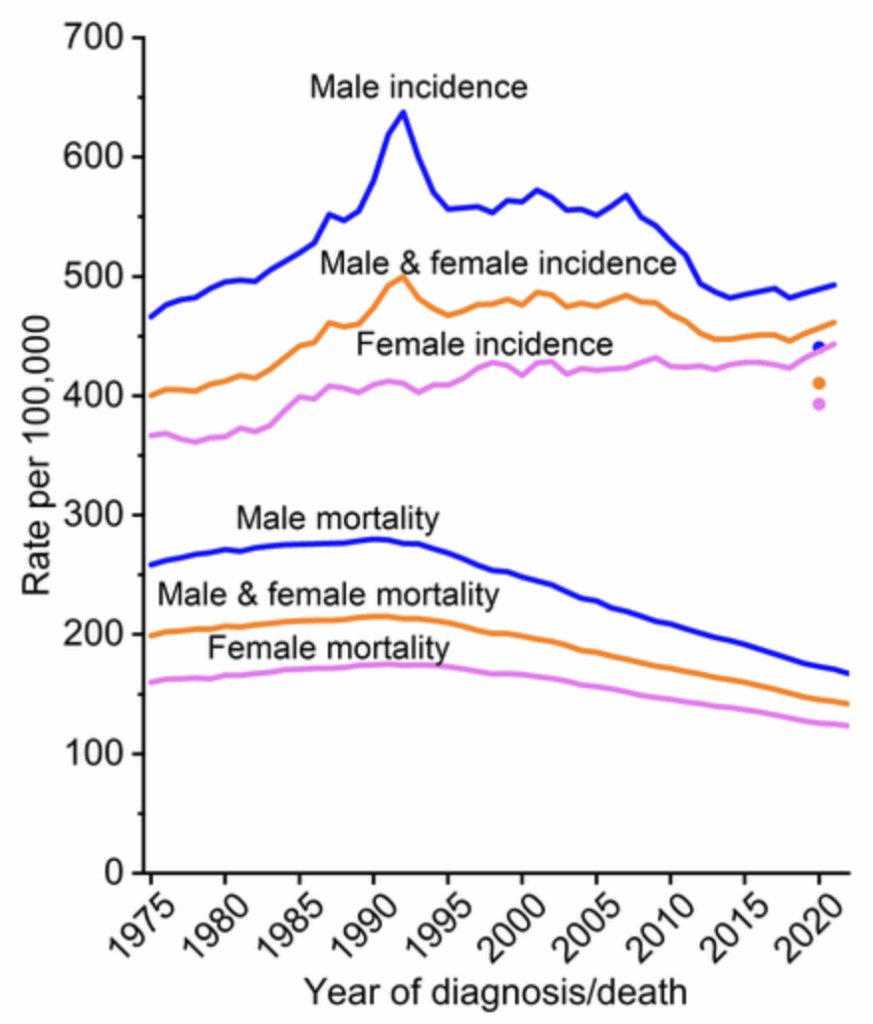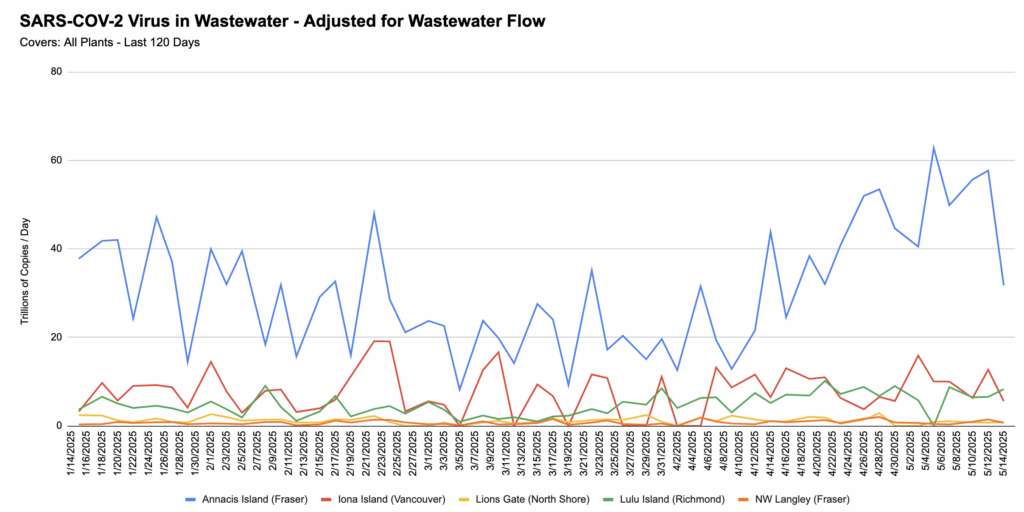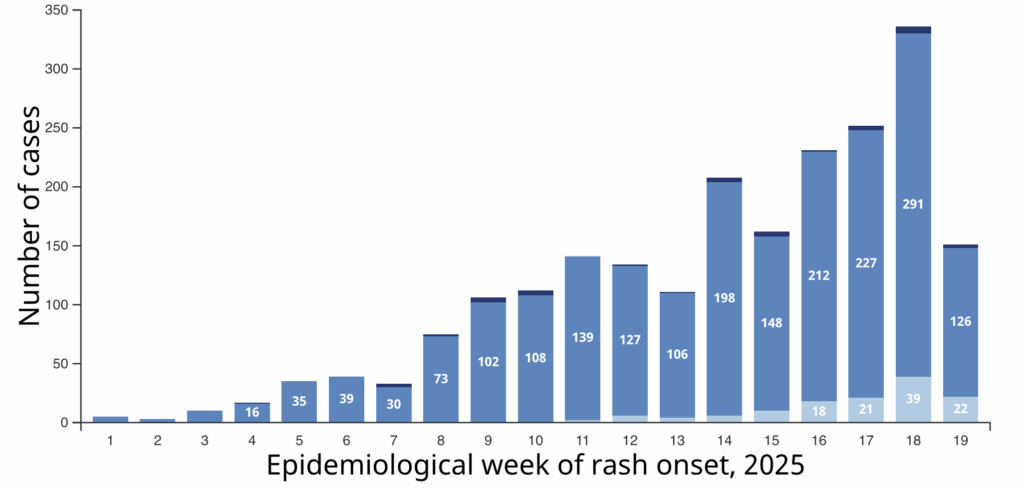COVID-19
Variants
Other people are starting to notice all the cases in Asia. This article from USA (2025-05-23) says that CDC has discovered a bunch of cases of NB.1.8.1 — the variant which is causing havoc in Asia — in wastewater arriving in planes from abroad. I know, I know, the US is not Canada, but people come from the same places to Canada.
💉 This press release (2025-05-16) says that the EU’s vaccine committee recommends that the next season’s COVID-19 vaccine be based off of the LP.8.1 strain.
💉Meanwhile, this article (2025-05-22) reports that the US has asked that manufacturers use either LP.8.1 or JN.1-lineage (which IIUC would include KP.2). This surprised me a bit, because this policy paper (2025-05-20) reports that going forward, the Food and Drug Administration anticipates requiring large randomized controlled trials with the controls getting a placebo for all vaccines — even for just updating the strains used in previously approved vaccines. (Yes, giving some participants an ineffective treatment when an effective treatment is known is highly unethical.) It looked to me like this was a left-handed way of discouraging future vaccines.
🇨🇦 Now, Canada usually picks vaccines that the USA uses, but I don’t know how much is coincidence and how much is follow-the-leader. However, with so much flustercucking going on in the USA, I’m not at all convinced we’ll see the US approve any new vaccines any time soon. 🙁
Meanwhile, it’s not clear to me that LP.8.1 is the right strain to use, given that NB.1.8.1 is taking off in a big way right now (see above, under Variants).
According to this paper (2025-01-28) the lineage of LP.8.1 is:
JN.1 -> KP.1.1 -> LP.8 -> LP.8.1
while what I pieced together about NB.1.8.1 from this post, this preprint (2025-05-01), and this paper (2024-03-13):
XBB -> GW.5.1; XBB -> FL.13.4; GW.5.1+FL.13.4 -> XDE
BA.2 -> BA.2.86 -> JN.1
JN.1+XDE -> XDV.1 -> ? -> XDV.1.5.1 -> ? -> NB.1.8.1
So NB.1.8.1 seems like it is quite distant from JN.1 (what Novavax is based on), KP.2 (what Moderna and Pfizer are based on), and LP.8.1 (what the EU and the USA seem to be heading towards).
Long COVID
🏃♂️This paper from Ireland (2025-05-06) found that running club members who had previous COVID-19 infections had poor cardiovascular stress response habituation. Specifically, they had a higher blood pressure the second time they did a task, unlike club members who had never had a COVID-19 infection. They also had a higher heart rate in general.
This sounds to me like the “fight or flight” reflex — one of many things handled by the autonomic nervous system — is messed up. This echoes something I saw in this (long) discussion (2025-01-12) (which references this preprint ) of a particular Long COVID rehab program for post-exertional malaise. The article says that the lead researcher thinks that the autonomic nervous system is over-responsive to threats/challenges.
💨 Their rehab program starts out with breathwork, which sounds really basic and kind of stupid — I mean, everybody knows how to breathe, right? Well, as it turns out, no. Breathing is something that the autonomic nervous system (ANS) regulates, and apparently if the ANS is messed up, breathing gets messed up. They explicitly describe their program as retraining the ANS. (After retraining people on how to breathe, then they do very gentle and gradually increasing exercises, which are harder for me to square with retraining the ANS, but maybe it’s training the ANS how to respond when the body moves?)
🧠 This paper from China (2025-04-21) found that people who had had COVID-19 infections had significant cognitive declines after three months, but that it got back to near-normal by 12 months. They also found increased activity in the glymphatic system (the brain’s garbage disposal system), even at 12 months, compared to healthy controls.
🩸 This paper from USA (2025-05-22) found that people with Long COVID had about 1% lower blood oxygenation than controls during sleep but not during wakefulness. 1% may not sound like a lot, but this paper says that 94% is the bottom of the normal range and a blood oxygen level of 92% requires urgent admission to hospital. A 1% absolute drop is about 16% of your breathing room, so to speak.
🧬 This large study (2025-05-21) found that variants of a gene, FOXP4, are highly associated with Long COVID.
🎉🎉🎉🐁 This preprint from USA (2025-05-15) reports that when mice are infected with COVID-19, their movement patterns change in a way that AI is able to classify the mice into distinct behavioural clusters of “Long COVID” mice and unaffected mice. The brains of the cognitively challenged mice have transcriptomic alterations similar to the transcriptomic alterations seen in Long COVID human brains. This means that they can now study Long COVID in mice!
Pathology
⚽️💪 This older study from Italy (2024-03-15) found that professional football (soccer) players were 36% more likely to have muscle injuries after having level II or level III COVID-19 than players who did not have COVID-19. Players with a level I infection — asymptomatic — had essentially the same risk as players who had never been infected.
NB: Level I is asymptomatic or presymptomatic; Level II is mild illness; Level III is evidence of lower respiratory diseases and have a blood oxygen level below 94%. (See Table 1.)
🧠 This paper from Hungary (2025-05-21) reports that young adults who had prior COVID-19 infections scored worse on cognitive tests than young adults who had never had COVID-19. People who had Long COVID scored worse than people with prior infections who did not have Long COVID, but even the latter cohort did not perform as well as the ones who’d never had COVID at all.
This table shows the percent of people in each group who scored in the bottom quartile of historical norms on various cognitive tests:
| Task | never COVID | had COVID but not Long COVID | has Long COVID |
| divided attention | 47.1% | 56.1% | 68.8% |
| response inhibition | 41.2% | 35.1% | 56.2% |
| verbal working memory | 5.3% | 8.8% | 37.5% |
| cognitive flexibility | 17.6% | 24.6% | 25.0% |
These were long-lasting cognitive problems: the participants who’d had COVID-19 had it, on average, 1.4 years before this study.
NB1: I had expected that exactly 25% the young adults who had never had COVID-19 would be in the lower quartile, but the proportion was never 25%. Way more (41.2%) of the NOVIDs scored poorly on the divided attention task, and way less on the verbal working memory task (5.3%). I have no explanation or even guesses.
NB2: The percentages-of-bottom-quartile given in the body of the paper didn’t match the figures in the Discussion section of the paper. I used the Discussion numbers. I have sent email to the primary contact asking about the discrepancy.
Vaccines
🦀 One of my readers pointed me at this paper from USA (2024-05-03) which they found concerning. There’s a protein p53 which plays a watchdog role to keep cells from turning cancerous. The paper says that the SARS-CoV-2 spike protein interferes with p53, which I interpret to mean that you’d be more susceptible to cancer.
My reader asked if that meant we should avoid vaccines that deliver SARS-CoV-2 spike to our bodies (which right now means all of the vaccines). I dug into this question a little, and think I’m not too worried about getting COVID-19 vaccines.
- We are all going to get spike protein delivered to our bodies. If we don’t get it from vaccinations, we’re going to get it from infections. I didn’t find any sources which said how much spike was delivered by vax vs. infection, but my intuition is that vaccines deliver less spike than infections do: vaccines make you feel like shit for a day, while COVID-19 makes you feel like shit for a week or two. (This is not scientific!)
- This article (2023-07-31) points out that mRNA vaccines deliver instructions for spike, not the spike itself. The spike only gets made inside the cell, and — unlike the full SARS-CoV-2 virus — the spike doesn’t have the machinery to get out of the cell. If I understand correctly, as part of the normal function of the cell, the cells routinely rips up stuff that’s floating around inside the cell and pastes those fragments on the outside of the cell. It’s those fragments that the immune system sees, not the entire spike.
- Two papers — one in macaques (2020-03-24) and one in mice (2022-08-02) — used clever techniques to see where intramuscular vaccines (HIV-1 vax in the mice and flu in the macaques) went. Both studies found out that most of the vax stayed in the injection site, a lot went to nearby lymph nodes, and a small amount went far away.
- To be fair, this paper from Japan (2025-04-03) says that they found spike protein in cerebral arteries of stroke patients with no nucleocapsid proteins (i.e. they did not have an active infection). This doesn’t sound like the vaccine-induced spike proteins stayed in the cells, nor did they stay in the deltoid+lymph nodes. I don’t know how the spike protein would get out of cells, but maybe the cells burst because of mechanical stress (i.e. a laceration or fracture) or a burn?
- If the spike protein really does mess with the cancer-suppressing machinery, wouldn’t we be seeing it? I have heard mutterings on teh socials that cancer rates are going up, so I have been keeping my eyes out for more reliable sources, and haven’t seen them. This article (2025-05-20) does say that cancer rates have risen — but between 2010 and 2019, before the pandemic started.
- This report from the American Cancer Society (2025-01-16) has data through 2021 and does not reveal a big spike in 2020.

Cancer diagnosis and mortality rates
💉 This article (2025-05-21) reports that Moderna has withdrawn its combo COVID+flu vaccine from US FDA consideration (because of the bullshit extra studies the FDA is asking for), and will reapply later in 2025.
Canadian vaccine approvals are more opaque than US procedures, so I don’t have any idea if or how this will affect Canadian vaccinations.
COVID-Related Excess Deaths and Sickness
This paper from Japan (2025-05-23) reports that getting COVID approximately doubles the risk of needing an amputation, and that this risk lasts for at least two years.
BC
💩 I don’t know what is going on with wastewater. From Jeff’s wastewater spreadsheet:

Recommended Reading
🧠 This blog post (2025-05-16) is by someone who had (and recovered from) brain fog after COVID-19, reads a lot of feeds, and thinks a lot of the authors he used to respect are now spouting unskilled drivel. He thinks it’s likely that a lot of people now have cognitive declines and are trying to cover it up with AI. 😬
🧠 The author of this post (2024-06-24) also said that they are noticing a lot of people who have problems with simple cognitive tasks.
H5N1
Transmission
🐄🐦⬛🤧 This article (2025-05-16) reports that 1,065 dairy herds from 17 states have tested positive by now.
Measles
From the Government of Canada’s measles info page (data up through 2025-05-10), Canada is still having measles: 315 cases nationally, 194 in Ontario, 87 in Alberta, 24 in Manitoba, 10 in Saskatchewan, 0 in BC or elsewhere.

